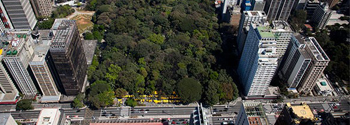PERCEPTION AND COMFORT OF USERS OF THE TRIANON PARK IN SÃO PAULO CITY
DOI:
https://doi.org/10.11606/issn.2179-2275.v8i2p59-73Keywords:
Thermal Comfort, Urban Environment, Microclimate, Trianon Park, Supervised ClassificationAbstract
The excess of soil sealing and the growing verticalization, together with the densification of the great metropolitan centers, have been affecting the thermal conditions of the urban environment. The presence of vegetation in urban parks may mitigate these effects as it provides more comfort to its users. The present study analyzes the perception and comfort of the users of the Tenente Siqueira Campos Park (Trianon) in São Paulo City. The quantity of arboreal covering in the study area, as well as in its surroundings, was calculated by the supervised classification method. For the thermal conditions evaluation, the following climatic variables were considered: temperature and relative air humidity, globe temperature and the speed of the wind, aiming to verify the conditions of the local microclimate. Questionnaires containing queries related to comfort and thermal sensation were applied to the users aiming to detect the degree of satisfaction in relation to the park. It was observed through the interviewees’ reports, that they showed satisfaction and well-being at the analyzed site. The measured climatic variables showed pleasant microclimate conditions with temperature (max. 29°C and min. 22,80°C) and relative air humidity (max. 69% and min. 49%), thus contributing to the comfort of the users. It was highlighted the interference of the presence of vegetation in the sense of well-being of the interviewed population, testifying the positive impact of the trees inserted in the urban environment.Downloads
References
CHENG, V.; NG, E.; CHAN, C.; GIVONI, B. An experiment of urban human thermal comfort in hot and humid sub-tropical city of Hong Kong under high density urban morphological conditions, Hong Kong. In: JAPANESE-GERMAN MEETING ON URBAN CLIMATOLOGY, 2009.Freiburg. Proceedings… Freiburg, 2009.p.179-184
COHEN, P.; POTCHTER, O.; MATZARAKIS, A. Daily and seasonal climatic conditions of green urban open spaces in the Mediterranean climate and their impact on human comfort, Building and Environment V.51, 2012, p. 285-295
DACANAL, C.; LABAKI, L. C. Vamos passear na floresta! O conforto térmico em fragmentos florestais urbanos, Ambiente Construído, Porto Alegre, v. 10, p.115-132, 2010
DIMOUDI, A.; NIKOLOPOULOU M. Vegetation in the urban environment: microclimatic analysis and benefits. Energy Building, v.35, p.69-76, 2003
DOBBERT, L. Y.; PRATA-SHIMOMURA, A. R.; MENDES, F. H.; SILVA FILHO, D. F. The influence of tree canopy cover on urban thermal comfort, Pluris - reinventar a cidade em tempos de mudança, 6º congresso luso-brasileiro para planeamento urbano, regional, integrado e sustentável, Fundação Calouste Gulbenkian, Lisboa, p.1509-1516,2014.
HARTIG, T.; MITCHELL, R.; DE VRIES, S.; FRUMKIN, H. Nature and health. Annu Rev Public Health, V.35, P. 207-228, 2014.
KÁNTOR, N.; UNGER, J. The most problematic variable in the course of human-biometeorological comfort assessment – the mean radiant temperature, Central European, Journal of Geosciences v.3, p.90-100, 2011.
KAPLAN, S.; KAPLAN, R. Cognition and environments, functioning in an uncertain world. Ann Arbor: University of Michigan; Ed. Ulrich’s Books, 287 p., 1983.
KAPLAN, S. The Restorative Benefits of Nature: Toward an Integrative Framework. Journal of Environmental Psychology, v. 15, p.169-182, 1995.
MC PHERSON, E. G.; SIMPSON, J. R.; XIAO, Q.; WU, C. Million trees Los Angeles canopy cover and benefit assessment. Landscape and Urban Planning, Amsterdam, v. 99, p. 40–50. 2011.
NORTON, B. A.; COUTTS, A. M.; LIVESLEV, S. J.; HARRIS, R. J.; HUNTER, A. M.; WILLIAMS, N. S. G. Planning for cooler cities: A framework to prioritise green infrastructure to mitigate high temperatures in urban landscapes. Landscape and Urban Planning, v.134, p. 127–138, 2015.
OLIVEIRA, L. A.; MASCARÓ, J. J. Análise da qualidade de vida urbana sob a ótica dos espaços públicos de lazer. Ambiente Construído, v. 7, n. 2, 2007, p. 59 – 69.
SENANAYAKE, I. et al. Remote sensing based analysis of urban heat islands with vegetation cover in Colombo city, Sri Lanka using Landsat-7 ETM+ data. Urban Climate 5, p. 19-35, 2013.
SHASHUA-BAR, L.; TSIROS, I. X.; HOFFMAN, M. E.. A modeling study for evaluating passive cooling scenarios in urban streets with trees. Case study: Athens, Greece, Building and Environment , 45, p.2798-2807, 2010.
SHASHUA-BAR, L.; PEARLMUTTER, D.; ERELL, E. The influence of trees and grass on outdoor thermal comfort in a hot-arid environment. International Journal of Climatology, Chichester, v. 31, p. 498-506. 2011.
SPANGENBERG, J., SHINZATO, P., JOHANSSON, E., DUARTE, D. Simulation of the influence of vegetation on microclimate and thermal comfort in the city of São Paulo, Revsbau, V.3, n.2, p. 1-19, 2008.
ULRICH, R. S. Natural versus urban scenes: some psychophysiological effects. Environment & Behavior, Ann Arbor, v. 13, n. 5, p. 523-556, 1981.
ULRICH, R. S. Health Benefits of Gardens in Hospitals. Paper for conference, Plants for People, International Exhibition Floriade, 2002, 10p.

Downloads
Published
Issue
Section
License
O detentor dos direitos autorais é o autor e eventuais coautores do artigo. A Revista LABVERDE exige apenas o ineditismo na publicação do artigo. O autor tem o direito de divulgar seu artigo conforme sua conveniência devendo citar a revista.
A Revista LABVERDE autoriza a republicação de seus artigos desde que devidamente citada fonte e autoria.


